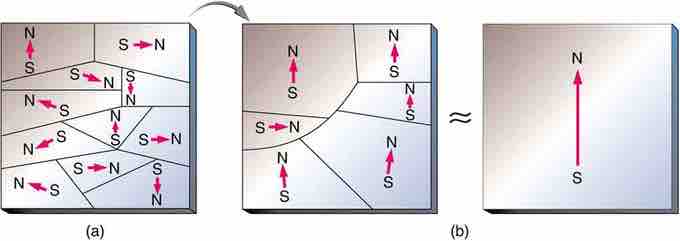Ferromagnetism is the basic mechanism by which certain materials (such as iron) form permanent magnets, or are attracted to magnets. In physics, several different types of magnetism are distinguished. Ferromagnetism is the strongest type—it is the only type that creates forces strong enough to be felt, and is responsible for the common phenomena of magnetism encountered in everyday life.
When a magnet comes into close proximity with a previously unmagnetized ferromagnetic material, it causes local magnetization of the material with closest unlike poles. Regions within the material (called domains) act like small bar magnets. Within domains, the poles of individual atoms are aligned. Each atom acts like a tiny bar magnet. Domains are small and randomly oriented in an unmagnetized ferromagnetic object. In response to an external magnetic field, the domains may grow to millimeter size, aligning themselves. This induced magnetization can be made permanent if the material is heated and then cooled, or simply tapped in the presence of other magnets, as shown in . Permanent magnets (materials that can be magnetized by an external magnetic field and remain magnetized after the external field is removed) are ferromagnetic, as are other materials that are noticeably attracted to them.

Unmagnetized to Magnetized Iron
(a) An unmagnetized piece of iron (or other ferromagnetic material) has randomly oriented domains. (b) When magnetized by an external field, the domains show greater alignment, and some grow at the expense of others. Individual atoms are aligned within domains; each atom acts like a tiny bar magnet.
Ferromagnetism arises from the fundamental property of an electron; it also carries charge to have a dipole moment. Thus, an electron itself behaves as a tiny magnet. This dipole moment comes from the more fundamental property of the electron—its quantum mechanical spin. The quantum mechanical nature of this spin limits the electron to only two states: with the magnetic field pointing either "up" or "down" (for any choice of up and down). When these tiny magnetic dipoles are aligned in the same direction, their individual magnetic fields combine to create a measurable macroscopic field.
However, in materials with a filled electron shell, the total dipole moment of the electrons is zero, as the spins are in up/down pairs. Only atoms with partially filled shells (i.e., unpaired spins) can have a net magnetic moment. Thus ferromagnetism only occurs in materials with partially filled shells. (According to Hund's rules, the first few electrons in a shell tend to have the same spin, thereby increasing the total dipole moment. )
Accordingly, only certain materials (such as iron, cobalt, nickel, and gadolinium) exhibit strong magnetic effects. Such materials are called ferromagnetic, after the Latin word for iron, ferrum. A group of materials made from the alloys of the rare earth elements are also used as strong and permanent magnets (a popular one is neodymium). Other materials exhibit weak magnetic effects, detectable only with sensitive instruments. Not only do ferromagnetic materials respond strongly to magnets (the way iron is attracted to magnets), they can also be magnetized themselves—that is, they can be induced to be magnetic or made into permanent magnets.
Ferromagnetism is very important in industry and modern technology, and is the basis for many electrical and electromechanical devices such as: electromagnets, electric motors, generators, transformers, and magnetic storage (e.g., tape recorders and hard disks).

Refrigerator Magnets
Different magnets attached to the doors of a refrigerator.